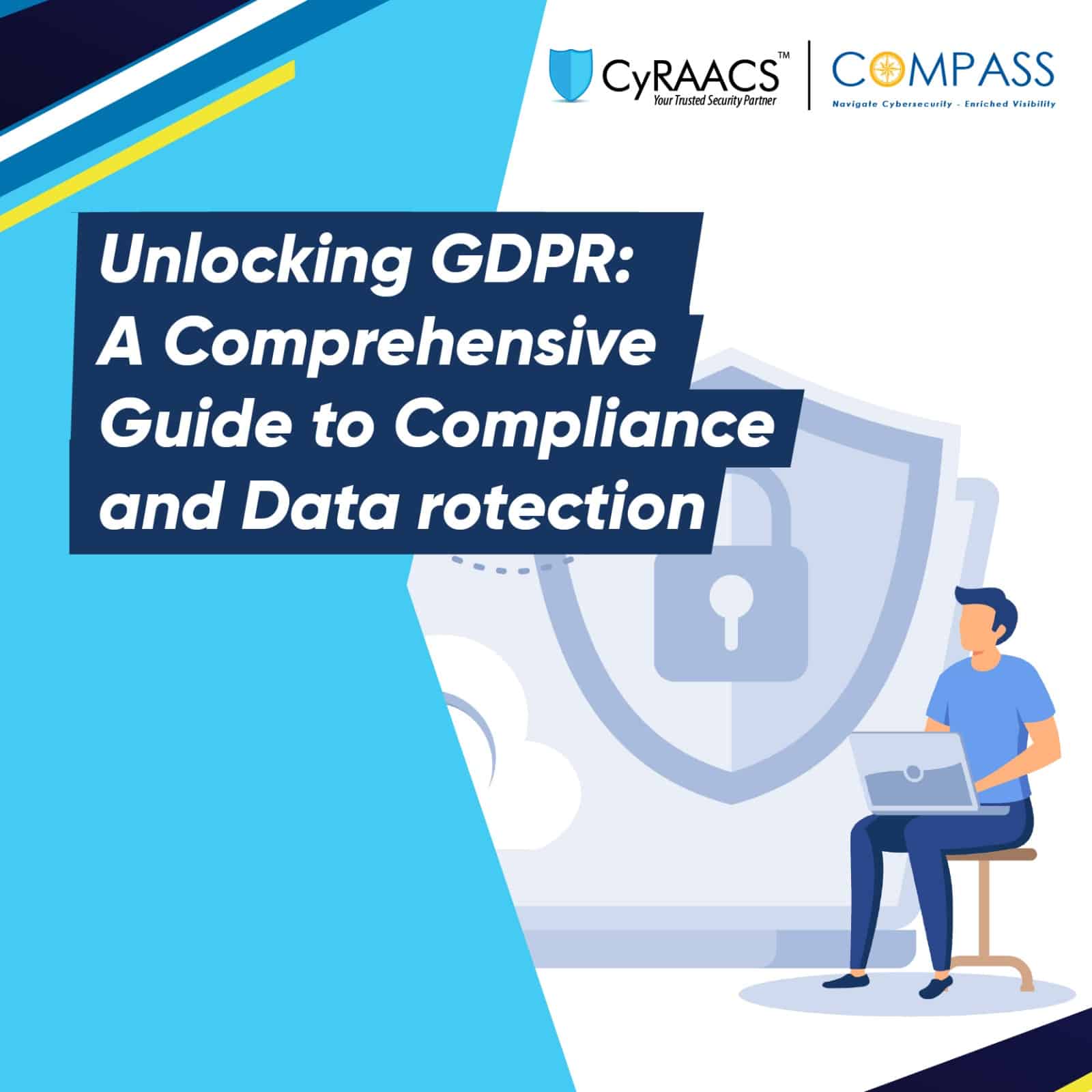Introduction
The General Data Protection Regulation is a law that was enacted in 2018, it has transformed the way businesses worldwide handle and protect personal data. With stringent requirements for data privacy and security, GDPR compliance is essential for organizations that collect, process, or store personal data of individuals in the European Union (EU), also extends to data of citizens of European Union (EU) being stored in other countries.
In this comprehensive guide, we'll walk you through the key aspects of GDPR compliance and provide a roadmap for ensuring your organization adheres to these regulations.
What is GDPR?
GDPR is a comprehensive data protection regulation that aims to provide individuals in the EU greater control over their personal data. It addresses how personal data should be collected, processed, stored, and protected by organizations. GDPR applies to businesses and entities located within the EU, as well as those outside the EU that handle the data of EU residents.
What is covered under GDPR?
The following domains/areas are protected under GDPR for data of the citizens of the EU:
- Personally identifiable information, including names, addresses, date of births, social security numbers
- Web-based data, including user location, IP address, cookies, and RFID tags
- Health (HIPAA) and genetic data
- Biometric data
- Racial and/or ethnic data
- Political opinions
- Sexual orientation
For whom is GDPR mandatory?
GDPR is a law and is applicable to any organization that stores, processes and uses data of citizens in the EU. The following entities have to be compliant with GDPR:
- a company or entity which processes personal data as part of the activities of one of its branches established in the EU, regardless of where the data is processed.
- a company established outside the EU and is offering goods/services (paid or for free) or is monitoring the behaviour of individuals in the EU.
GDPR does not apply to companies which are service providers based outside the EU or if the company provides services to customers outside the EU.
The Key Principles of GDPR are
- Lawfulness, Fairness, and Transparency: Organizations must process personal data lawfully, fairly, and transparently, with clear consent from data subjects.
- Purpose Limitation: Data should only be collected for specific, legitimate purposes and not used for other unrelated activities.
- Data Minimization: Organizations should only collect and retain data that is necessary for the stated purpose.
- Accuracy: Personal data should be accurate, and steps should be taken to rectify inaccuracies.
- Storage Limitation: Data should be stored for only as long as necessary for the intended purpose.
- Integrity and Confidentiality: Data must be processed securely and protected against unauthorized access or disclosure.
Key rights of Data subjects
GDPR grants several rights to its Data subjects, some of them are as follows:
- Right to Access: Data subjects can request access to their personal data held by an organization.
- Right to Be Forgotten: Individuals can request the deletion of their data under certain circumstances.
- Right to Data Portability: Data subjects have the right to receive their data in a structured, commonly used, and machine-readable format.
- Right to Object: Individuals can object to the processing of their data, particularly for direct marketing purposes
Steps to GDPR Compliance
Achieving GDPR compliance involves a series of steps to ensure your organization adheres to its principles and respects the rights of data subjects.
- Appoint a Data Protection Officer (DPO):
- If your organization processes large amounts of personal data or processes special categories of data, you may need to appoint a DPO.
- Conduct a Data Privacy Impact Assessment (DPIA):
- For high-risk processing activities, conduct a PIA to identify and mitigate potential privacy risks.
- A DPIA helps identify and mitigate potential risks to data subjects' rights and freedoms. It's especially important when introducing new data processing operations.
- Data Privacy Policies:
- Develop clear and concise data privacy policies and procedures. Ensure that your privacy policies are readily accessible to data subjects, providing information about data collection, processing, and the rights of individuals.
- Integrate data protection principles into the design and development of new products, services, and processes.
- Develop a mechanism to obtain consent
- Implement mechanisms for obtaining valid consent for data processing activities. Ensure that individuals are informed about their rights and have the option to opt out.
- The consent must be valid, informed, and unambiguous and must be obtained from individuals before collecting and processing their personal data.
- Data Security Measures:
- Enhance data security by implementing technical and organizational measures to protect personal data.
- This includes encryption, access controls, regular security assessments, and employee training.
- Create a Data Breach response plan
- Establish procedures for responding to data subject requests, including access, rectification, erasure, and data portability.
- It's crucial to have a process in place for handling these requests promptly.
- Data Processing Records:
- Keep transparent records of your data processing activities, including the purpose, category of data, data recipients, and data retention periods.
- This documentation is vital for demonstrating compliance.
- This would have to be displayed in a public forum relating to the organization, ideally.
- Train Employees:
- Provide regular training to employees on GDPR compliance, including data handling procedures and incident response protocols.
- Third Party contracts
- Review and update contracts with third-party data processors to ensure they comply with GDPR requirements. Data controllers are responsible for the actions of their data processors.
- In case of third-party vendors that may have access to PII data or EPHI data it is necessary to sign a Business Associate Agreement (BAA) with them.
- Establish Regular Audits, Assessments and reviews
- Regularly audit and assess your data processing activities, security measures, and compliance efforts as defined in your policies. This helps identify and rectify any issues or vulnerabilities.
- Regularly review and audit data processing practices to ensure ongoing compliance with GDPR requirements.
- If your organization is present in multiple regions, then it is necessary to have a DPO for each region separately.
How can your organization be GDPR compliant?
Irrespective of the size of your organization, you can give GDPR compliance a shot by following the processes listed below:
- Transparency
It is essential that you know your data. Conduct audits to establish what information you have and who has access to it. Make sure you can legally justify all your data processing activities and you have a clean understanding of all the processes and can convey the same in a clear manner.
Data privacy and data security must be always the primary focus. This includes implementing appropriate technical and organizational measures to protect data. Technical measures include but is not limited to encryption. Organizational measures include limiting the amount of personal data that is collected and deleting data that no longer serves any purpose. Encrypt or anonymize data wherever possible. Create and enforce an internal security policy for your team members. Conduct a data protection assessment and have clear processes defined to carry it out. In the event of a data breach, make sure you have well defined procedures to keep all employees informed.
- Accountability and governance
Appoint someone who would be responsible for GDPR compliance over your organization. Make sure you sign data processing agreements between your organization and any third-party vendors whose services you avail. If your organization is outside the EU, appoint a representative within one of the EU member states. Appoint a DPO.
Transparency with customers is essential, at any point of time they should be able to request and receive information that you have about them. They should also be able to update or delete their information as and when they want to. They should also be able to terminate the processing of their data by your company with ease. It is up to you company to protect the rights of customers.
Following this checklist might not have you compliant with GDPR entirely, but it significantly reduces your exposure to risk and regulatory penalties.
Benefits of compliance with GDPR
- Enhanced Customer Trust: Demonstrates a commitment to protecting customer data, fostering trust and loyalty.
- Reduced Risk of Data Breaches: Mitigates the risk of costly data breaches and associated reputational damage.
- Improved Operational Efficiency: Streamlines data management processes and enhances overall efficiency.
- Competitive Advantage: Gain a competitive edge by providing a secure and privacy-conscious environment for customers
Penalties for Non-Compliance
Non-compliance with GDPR can result in significant fines, which can be as high as €20 million or 4% of an organization's global annual turnover, whichever is higher. Additionally, reputational damage and potential legal action from data subjects are other consequences of failing to comply.
How can COMPASS help?
COMPASS, a specialized lightweight platform, enhances your Internal Audit and external audit processes and user experience. Some of the benefits of using COMPASS include:
- In built Standards and Control Libraries with over 30+ International and Domestic Standards, including GDPR
- Ability to create and upload your own Standards and perform assessments based on those standards.
- Modules for Risk Assessment and Standard Assessment.
- Centralized data and documentation for easier access and review.
- Enhanced communication and collaboration between auditors and auditees.
- Streamlined reporting, with instant audit report generation.
- Tracking of issues and exceptions for all issues identified during the audit.
- Continuous monitoring and real-time visibility into security risks and compliance status.
- Dashboards and analytics supporting data-driven decision-making.
- Gives an auditor’s perspective to users and helps understand the process of audits better.
Conclusion
GDPR compliance is not an option but a legal obligation for organizations handling personal data of EU residents. By following the steps outlined in this guide, organizations can establish a robust data protection framework that not only meets GDPR requirements but also fosters trust with customers and stakeholders. Compliance is an ongoing effort, and staying up to date with regulatory changes is essential to maintaining data privacy and security in the digital age.

